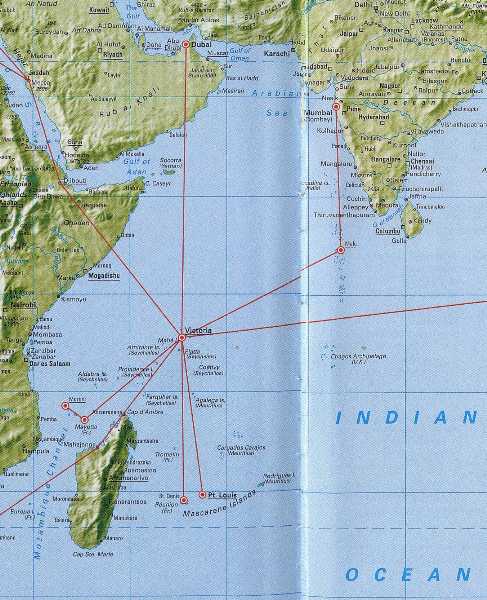
13 F.S.S. detachment to the Seychelles (December 1957 to March 1958)
By Trevor ‘Bill’ Powell (then Cpl.)
In December 1957, Sgt. Mick Dyall and myself were told that we should accompany the Sqn. OC, Major Covington, to the War Office (as the Ministry of Defence was then called). There we were informed that the Royal Navy oceanographic survey ship HMS Owen was to carry out charting work in the Indian Ocean around the Seychelle Islands and that we were to go with them and carry out field trials on a new distance-measuring instrument called the Tellurometer (after the Geodimeter, yet another name meaning ‘Earth measurer’), at the same time providing co-ordinates for the Owen’s radar shore slave stations.
On boarding the Owen at Aden, we found seven other R.E.survey members, namely Captain Bob Mills, Sgt. Fred Grist, Cpl. Roy Isherwood, Spr. Mike Layland, Spr. Bud Moon, Spr. Geoff Dean and Spr. Mick Graham from various MELF units. They would go with us to the earthly paradise called The Seychelles.
There are between 86 and 133 islands in the group (depending on which source you consult), spread over quite a large area of the Indian Ocean, and which have a total land area of about 156 square miles (404 sq.km). The population in 1958 was near to 42.000, the great majority living on the main island Mahé, with 15.000 to 20.000 of them in or around the capital Victoria. By the year 2000, the population had grown to 82.000, of whom 59.500 on Mahé and probably about 25.000 of them in Victoria. They are a wonderful mix of ethnic descent, African, Indian, British, French, Chinese, Arabic, with skin that ranges from white to black, through all the shades of brown, hair all shades from blond to black and eyes of blue, brown or green. The local language is Creole, a French patois, but English and French are widely spoken.
Later in 1959, Mike Layland wrote an article about the trip which he kept. In 2005 I too wrote my memoirs of the trip and we exchanged versions. Although there were some differences (memory is what it is after 48 years), the basic elements tied up very well. Here are a few photos of our adventure and a couple of, hopefully, interesting extracts from my tale.

The main islands in the Seychelles group
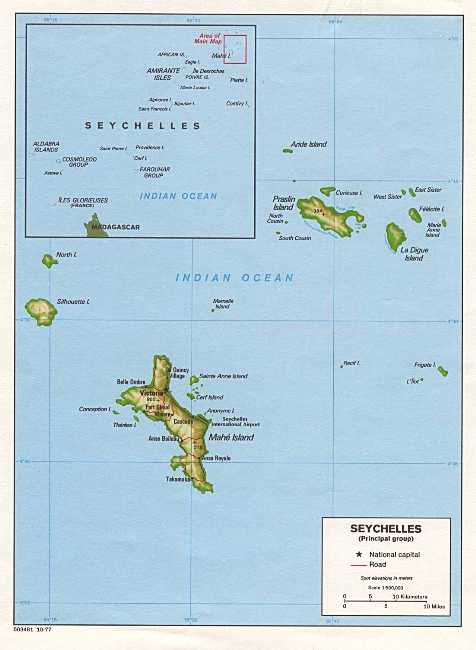
Island of Mahè in the Seychelles

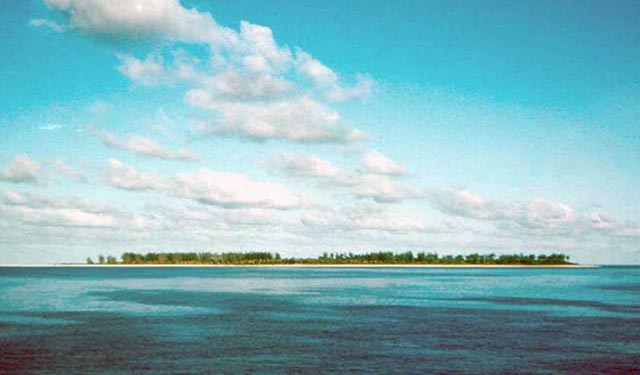
Above: Our first view of the Seychelles (Bird Island) from aboard the HMS Owen
Below: Starting work with the Tellurometer on Bird Island
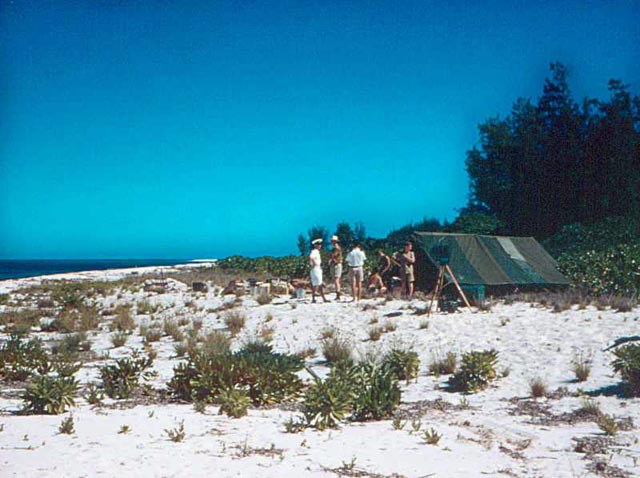
THE TELLUROMETER
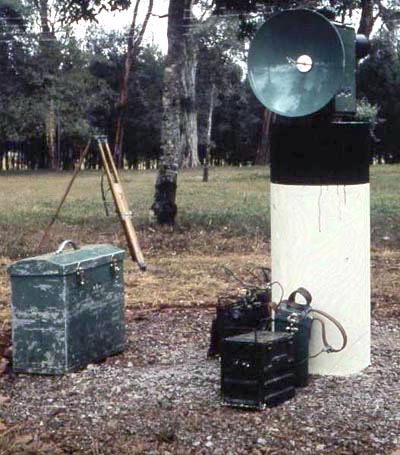
The instrument consisted of a Master unit and a Remote unit (like the one sitting on the concrete pillar), a carrying case for each unit, two wooden telescopic tripods, two 12V battery packs and two accessory cases containing the radio handsets etc. In the first version only the Master unit could carry out the distance readings whilst the Remote unit served as a ‘mirror' to redirect the radio wave back to the Master.
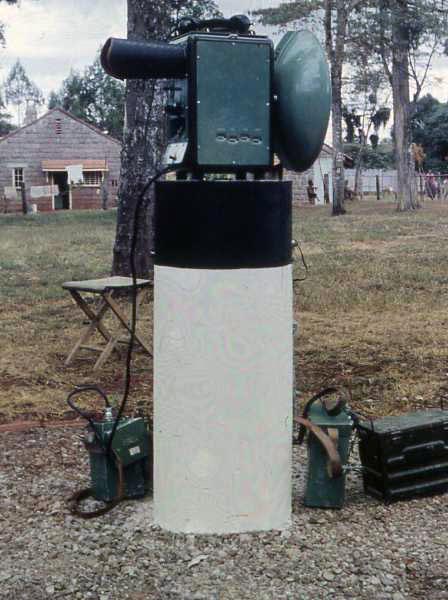
VICTORIA – SEYCHELLES (1958) (Photos by Bud Moon)
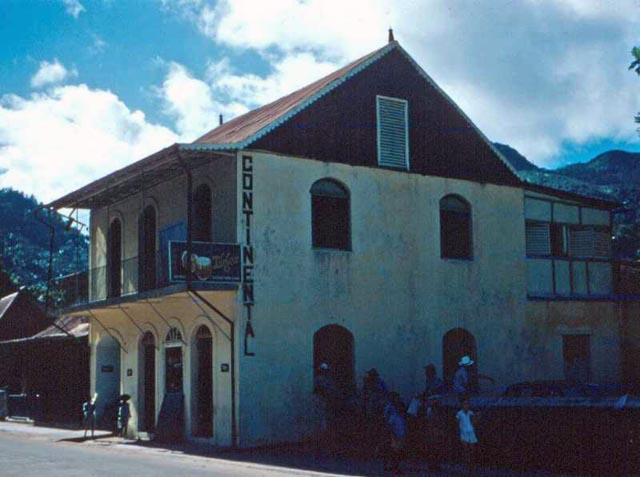
Above: The Continental Hotel where six of the party stayed.
Below: Victoria, looking from the Continental Hotel towards the port and the Pirates' Arms, where the officer and two sergeants lodged.
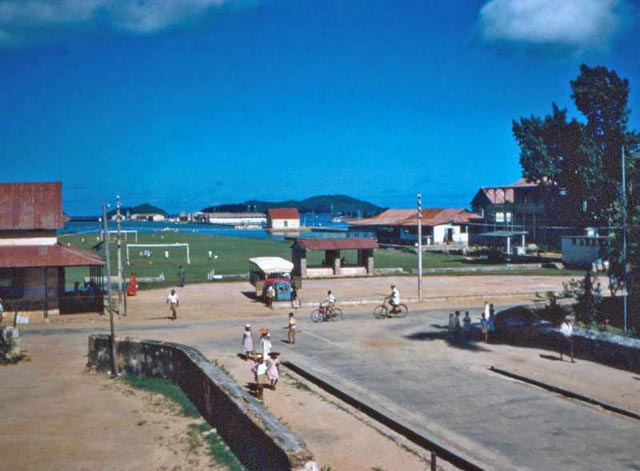
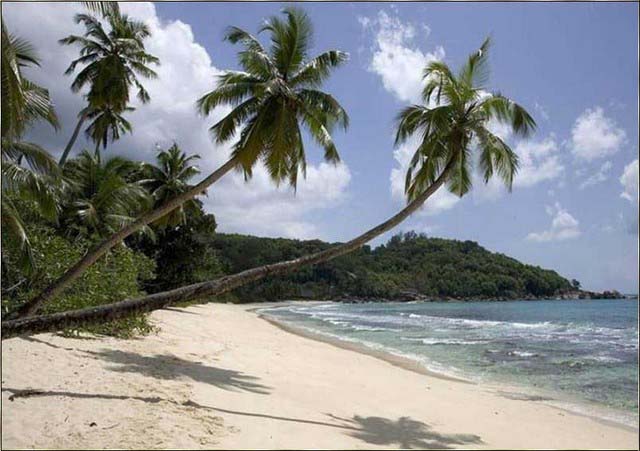
Views of Victoria (Mahé) and a typical Seychelles beach.
THE SEYCHELLES – January to March 1958
Surveyors at work (climbing a hill on recce.) and at play (on the beach)
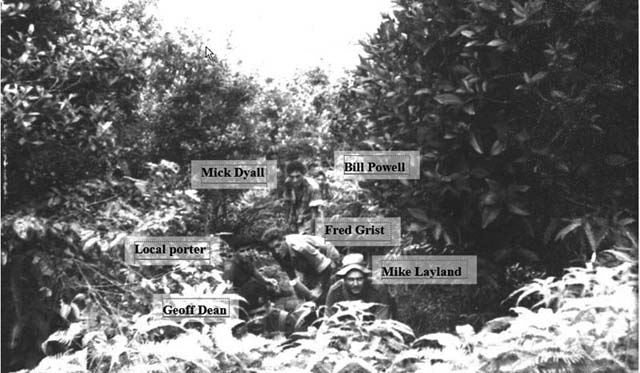
A survey party climbing the steep hill 1098 (so called because of its height in feet above sea level).
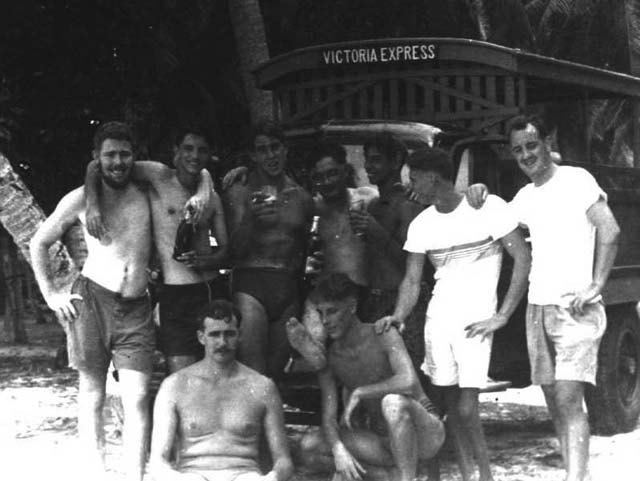
These photos were supplied to Bill Powell by Mike Layland in December 2005.
Some of the surveyors with some local friends near the beach. Behind the group is one of the Victoria Express buses.
Front row: Geoff Dean and Trevor ‘Bill' Powell.
Richard Mancham owned the Continental Hotel where the six lower ranks lodged. His son James became the first President of the Seychelles when they gained independence in 1976
Eureka! The amphibious EDM
This adventure (or disadventure) happened to Bud Moon and myself. One of our survey control points had been situated on a very small island, Ile Vache in Anse Royale on the south east coast of Mahé. To get there with our equipment (Tellurometer Remote station and theodolite) we had to ‘hire’ a native pirogue (dug-out canoe) together with a crew of two locals. The short journey across to the island was uneventful and we got our observations done without any problem, if you ignore the fact that the island was literally crawling with large lizards and thousands of millipedes up to about 18 inches long. They caused more a sense of repulsion than of real disturbance but we were glad to leave once our work was finished. We loaded all the equipment into the pirogue, with one of the locals in the bow with his paddle and Bud and myself amidships with the equipment.
The second local, instead of getting into the stern and pushing off with his paddle, decided to emulate James Bond by pushing the boat off into the water and then jumping in. He hit the side of the pirogue instead of the bottom and finished in the water with the boat rocking wildly from side to side. The rest of us stayed in quite miraculously and the only thing to go overboard was …... the Tellurometer! When I realised what had happened, my heart jumped into my mouth and the blood rushed to my head. They say that a drowning man sees all his past life flash across his inner eye in the space of a moment. I don’t know about that but I do know that when a surveyor’s Tellurometer is drowning, it’s his immediate future that flashes across his inner eye.
How do I explain to Captain Mills that the Remote instrument has been taken by King Neptune? Will I be shot at dawn or be given the chance of a Court Martial? How will the party now be able to complete the work without the Remote end of the instrument? Well, fate for once (and I must admit, not for the only time in my Army career) was kind to me. Fortunately the Tellurometer had a carrying case which, although not hermetic, contained sufficient air to enable it to float and support the weight of the instrument, with the lid sufficiently above the waves to avoid any water getting inside. It had assumed an upright position after it fell into the water so we quickly paddled after it as it bobbed merrily along on the current and pulled it on board. We also reluctantly allowed the local paddler, culprit of our disadventure, to regain his place and the trip was brought to a successful conclusion. Obviously Captain Mills was NOT informed of that part of the exercise.

A local fisherman returns home with his catch.
Fish was, and probably still is, of excellent quality and extremely cheap in the Seychelles.
Photo sent to Bill Powell by Mike Layland in December 2005.
Return to the U.K. from the Seychelles
This was an adventure within the adventure. Having completed our survey work on the islands and the Royal Navy also having finished the charting of the seas around the Seychelles, we were due to leave for Mombasa, in Kenya, on the HMS Owen about the middle of March 1958. We would then travel to Nairobi by train and Mick Dyall and myself would fly back to the UK with our favourite airline, the Royal Air Force, whilst the other surveyors would be flown back to Cyprus or Aden. Departure date was Sunday 9th March and the ship was to set sail at about 8 p.m. All non-essential crew members and of course we R.E. surveyors were all ashore enjoying the pleasures of this tropical paradise for a last time.
At about 10.30 a.m. the Owen received emergency sailing orders from the Admiralty in London. A seaquake (now better known as a tsunami) had caused extensive damage in the Maldive Islands to the south-west of Ceylon (now Sri Lanka) and the Owen was being sent to give help. The sailors were rounded up as quickly as possible, a very difficult task as they were spread throughout the pubs and clubs of the capital Victoria and in fact some could not be found in time and were left behind. We R.E. surveyors were all found, some at the Pirates’ Arms, some at Sharkey’s, some on a pic-nic on the beach, and were told that we were being left behind and our bags and belongings had been dumped on the jetty. I can’t say that the prospect of some extra days on shore, with little or no work to do, particularly bothered us (except for Captain Mills perhaps).
The ship sailed at some time in the early afternoon and we waved it goodbye from the pier. I didn’t realise at that moment that I was also waving goodbye to all my kit. In the haste and confusion, the mariners had not put my bags ashore with the rest. By the time I realised, it was too late. I was left with just what I had on, a light cotton khaki shirt, a pair of khaki shorts, underpants and a pair of non-regulation sandals. No head-gear (beret or jungle hat), no jacket, no long trousers, no web belt, no other military markings apart from a removable arm-band with my corporal’s stripes. This was no real problem in the tropics of course but was to prove problematic later on. Captain Mills did buy me a pair of long cotton trousers, another shirt and some underwear which gave me a change of clothing so at least I could wash the dirty ones through, but they were more suited to a tropical tourist rather than to a soldier.
We spent another very enjoyable week on Mahè before we definitely had to say goodbye to our girlfriends and board a civilian liner (I think it was called the States of Bombay, quickly nicknamed the States of Decay) bound for Bombay (now Mumbai). The ship plyed the route from Capetown, Durban, Mombasa, Seychelles, Bombay, to Karachi and return, stopping off at the Seychelles every two or three weeks in one direction or the other. The trip to Bombay, which took about six days if I remember correctly, was very pleasant. The crew and almost all the passengers were of Indian and Pakistan nationality, although some were living in South Africa or the East African states (Kenya, Tanganyika and Uganda).
On the first or second day we crossed the equator but I don’t remember there being any particular celebration to mark the event. Being as many of the passengers had done the trip several times, if Neptune had stepped aboard he would probably have risked being dumped unceremoniously straight back into his natural domain. Each evening after dinner there was some entertainment for the passengers in the ship’s lounge and one evening we Brits were invited to sing a song. Someone decided we would give a barber’s shop type rendering of the Foggy Foggy Dew, in my opinion not a particularly good choice for the particular audience we had. However we harmonised quite well considering our complete lack of practice and our effort was received graciously. Perhaps (fortunately) few if any of our audience followed the words too closely.
On arrival at Bombay (Mumbai) on the Saturday afternoon, we were immediately transboarded onto the cruiser HMS Gambia which was to sail on Tuesday bound for Aden. During the four or five day voyage to Aden, the Gambia carried out sea exercises, which consisted of RAF fighter-bombers from Aden and the other south Arabian peninsular RAF bases “attacking” the ship, which replied by firing live shells at the planes but with a 20° offset. In other words, the gun-sights were offset by 20° relative to the gun barrel. However it was quite exciting to see the shells bursting in the air behind the planes. I bet the pilots were happy too to see the shells bursting behind the planes.
Once at Aden, Mick and I were told that we were to fly back to the U.K. on Good Friday in, of all things, a Blackburn Beverly transport plane, a journey which would take two days! On Good Friday morning we took off in our mastodontic means of transport together with about six other passengers and perhaps four civilian cars belonging to Service personnel who had bought them duty-free in Aden and were getting them home free-of-charge, courtesy of the British taxpayer. Passenger accomodation in a Blackburn Beverly is not like first class on British Airways. It’s not even remotely comparable to business or tourist class on British Airways nor on the lowest cut-price carrier in existence. It’s rather like sitting in a canvas bucket-seat half-way up the wall of an aircraft hangar with a precarious gangway to reach the toilet. And the on-board meals were a perfect match. Anyway, we survived refuelling stops at Wadi Saidna (near Khartoum) and Wadi Halfa (near the Egyptian border), both in the Sudan, and arrived in the late afternoon at El Adem RAF base near Tobruk in north-east Libya. Here we were told that one of the plane’s engines was giving trouble so we would have to stay there until a replacement engine was flown in from Aden and mounted.
This happened during the course of the following morning and we left in the early afternoon, making a refuelling stop at Benina airport just outside Benghazi, and landing for a night stopover at Malta. We were taken to an transit Army camp for overnight accomodation and it was here that my lack of military clothing caused me my first major problem. I still only possessed the few rags I had left the Seychelles with. Walking through the camp I was affronted by the Regimental Sergeant Major with his pace-stick tucked neatly under his left arm. He looked me up and down and, controlling his mounting blood-pressure with some difficulty, asked of me “And who’s Army do you belong to, Corporal? You look as though you’ve been washed up by the incoming tide.”
Of course he wasn’t very far from the truth, so I took a deep breath and told my story. “Sir, I was in the Seychelles doing survey work when a seaquake hit the Maldives. My ship the HMS Owen had to leave on emergency sailing orders and I was left behind without my kit. I spent a further week in the Seychelles, a total of ten days on two other ships, four days in Aden and two days on a Blackburn Beverly with only what I am wearing. Tomorrow I go back to the U.K. where I hope to be issued replacement clothing.” He looked at me for some moments without speaking. He must have been trying to decide if I was telling the truth or not. I’m sure that of all the excuses and explanations he had listened to throughout his Army career, he had never heard one to top mine. Finally he turned on his heels and marched away without a word, probably to the Sergeants’ Mess to have a stiff whisky. I heaved a sigh of relief and, not without a smile on my lips, went on my way.
The next morning we boarded the B.B. again and were on our way, destination RAF Lyneham in Wiltshire. It was Easter Sunday and this, as the pilot soon informed us, meant that we could not make the scheduled refuelling stop at a French Air Force base in the south of France as the ground personnel had the day off. “Hopefully – continued the pilot – we will have enough fuel to reach Lyneham.” My unspoken question “And what happens if we don’t have enough?” went unanswered. However the journey was uneventful, the fuel was sufficient and we landed safely at Lyneham in the middle of a snow storm. From the warmth of the Mediterranean to the freezing cold of Lyneham and dressed for the tropics.
The RAF ground personnel looked at me in astonishment and one finally said innocently "Don't you feel a bit cold, mate?” Without repeating all my tragic story I conveyed the general sense of the situation to him and, to my great surprise but gratitude, he went off and quickly returned with a heavy roll-neck woolly sweater which he said was “buckshee”. Now feeling a little warmer I jumped into the Austin Champion jeep which had come to meet Mick and myself and take us back to dear old Fernhurst camp. My Seychelles adventure was over but remains in my memory as a real highlight of my life, an experience I shall never forget. And the breadfruit is still calling me back (and not only the breadfruit).
Whilst we were there, I think it was in February, a tropical storm hit the islands and an exceptional downpour occurred overnight with almost 20 inches (50 cm) of rain falling in eight hours. The event was even reported in the British newspapers, which otherwise had only written of the Seychelles because Archbishop Makarios was exiled there from Cyprus in 1956/1957. Manchester gets 40 to 50 inches per year!
With thanks to Trevor "Bill" Powel for this contribution.